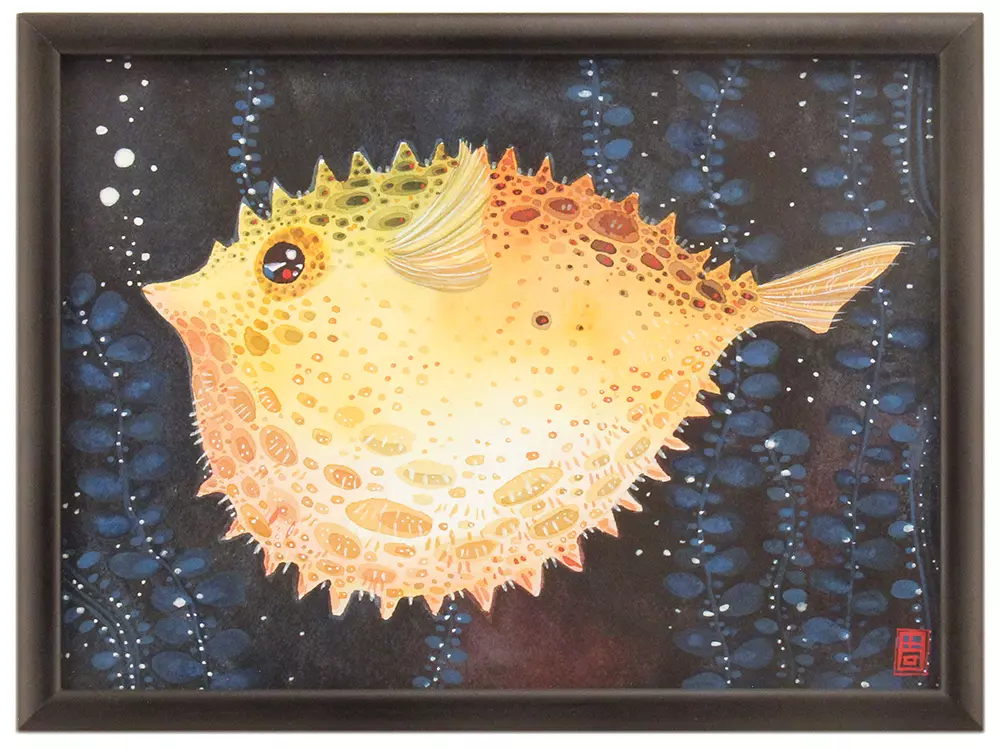Gallery Nucleus will be closed on Tue and Wed 1/13-1/14 for store maintenance! Will reopen Thur 1/15

| Artist: | Alina Chau |
| Exhibition: | Oceans & Currents |
| Art Width: | 11.0" (27.94 cm) |
| Art Height: | 8.5" (21.59 cm) |
| Art Depth: | 0.0" (0.0 cm) |
| Frame Width: | 12.0" (30.48 cm) |
| Frame Height: | 9.5" (24.13 cm) |
| Medium: | Watercolor |
| Features: |
Framed
Signed |
| Year: | 2021 |
The spotted porcupinefish (commonly referred to as a pufferfish) is one of several porcupinefishes, known for the very strong spines that cover their bodies and the ability to “puff up” like their close relatives, the puffers. The spotted porcupinefish is often known simply as the porcupinefish, but that can create some confusion with the other 17 species in this group of fishes.
This species is known to occur on coral and rocky reefs throughout the world’s tropical and subtropical seas, likely because it lives in the open pelagic ocean until it reaches a size of approximately eight inches (20 cm). However, an extensive genetic study of the spotted porcupinefish may reveal the existence of different species in different ocean basins (e.g., on either side of Central America). Unlike many blotchy species of porcupinefishes, this species is covered with small, regularly spaced spots.
The spotted porcupinefish, like all porcupinefishes, has very strong jaws and beak-like teeth. All the teeth in the upper jaw are fused into a single plate, and all the teeth in the lower jaw are fused into a single plate. In fact, the family name for porcupinefishes (Diodontidae) means “two teeth,” reflecting the single tooth plate that these fishes have on each jaw. Spotted porcupinefishes are foraging predators, and don’t eat other fishes. Instead, their specialized jaws and teeth are perfect for feeding on hard-shelled or spiny invertebrates, like urchins, snails, and crabs. They spend much of their time foraging for their preferred prey.
The spotted porcupinefish is a very poor swimmer and can easily be caught, even by SCUBA divers. However, when threatened, the spotted porcupinefish has the incredible ability to swallow water and erect its spines until it looks like a large, spiny balloon. Though the process takes a few seconds, when complete, it is almost 100% effective at preventing predation. It is very difficult (and potentially dangerous) for a predator to swallow an inflated spotted porcupinefish. When an individual no longer feels threatened, it uses muscles along its abdomen to push the water back out of its mouth. Even if successfully eaten (before it can inflate), the spotted porcupinefish can be poisonous to potential predators, so this species is rarely eaten on the reef.
The spotted porcupinefish is typically fairly uncommon but can reach large numbers at some locations. Its conservation status is currently unknown, but its rarity is likely a natural occurrence.
Your purchase of this piece contributes 20% to Oceana's ongoing efforts to preserve the habitats of beloved creatures like these. Learn more at Oceana.org.












![Leo [PRINT], Alina Chau Leo [PRINT], Alina Chau](https://84d70f39dda4f8d63311-09dac41207c435675bfd529a14211b5c.ssl.cf1.rackcdn.com/assets/attachments_p/000/111/179/size300_AlinaC_Leo_WEB.webp)
![Cancer [PRINT], Alina Chau Cancer [PRINT], Alina Chau](https://84d70f39dda4f8d63311-09dac41207c435675bfd529a14211b5c.ssl.cf1.rackcdn.com/assets/attachments_p/000/111/188/size300_AlinaC_Cancer_WEB.webp)
![Gemini [PRINT], Alina Chau Gemini [PRINT], Alina Chau](https://84d70f39dda4f8d63311-09dac41207c435675bfd529a14211b5c.ssl.cf1.rackcdn.com/assets/attachments_p/000/111/183/size300_AlinaC_Gemini_WEB.webp)
![Taurus [PRINT], Alina Chau Taurus [PRINT], Alina Chau](https://84d70f39dda4f8d63311-09dac41207c435675bfd529a14211b5c.ssl.cf1.rackcdn.com/assets/attachments_p/000/111/154/size300_AlinaC_Taurus_WEB.webp)
![Aries [PRINT], Alina Chau Aries [PRINT], Alina Chau](https://84d70f39dda4f8d63311-09dac41207c435675bfd529a14211b5c.ssl.cf1.rackcdn.com/assets/attachments_p/000/111/189/size300_AlinaC_Aries_WEB.webp)
![Pisces [PRINT], Alina Chau Pisces [PRINT], Alina Chau](https://84d70f39dda4f8d63311-09dac41207c435675bfd529a14211b5c.ssl.cf1.rackcdn.com/assets/attachments_p/000/111/151/size300_AlinaC_Pisces_WEB.webp)
![Aquarius [PRINT], Alina Chau Aquarius [PRINT], Alina Chau](https://84d70f39dda4f8d63311-09dac41207c435675bfd529a14211b5c.ssl.cf1.rackcdn.com/assets/attachments_p/000/111/152/size300_AlinaC_Aquarius_WEB.webp)
![Capricorn [PRINT], Alina Chau Capricorn [PRINT], Alina Chau](https://84d70f39dda4f8d63311-09dac41207c435675bfd529a14211b5c.ssl.cf1.rackcdn.com/assets/attachments_p/000/111/187/size300_AlinaC_Capricorn_WEB.webp)
![Sagittarius [PRINT], Alina Chau Sagittarius [PRINT], Alina Chau](https://84d70f39dda4f8d63311-09dac41207c435675bfd529a14211b5c.ssl.cf1.rackcdn.com/assets/attachments_p/000/111/156/size300_AlinaC_Sagitarius_WEB.webp)
![Scorpio [PRINT], Alina Chau Scorpio [PRINT], Alina Chau](https://84d70f39dda4f8d63311-09dac41207c435675bfd529a14211b5c.ssl.cf1.rackcdn.com/assets/attachments_p/000/111/155/size300_AlinaC_Scorpio_WEB.webp)
![Crux [PRINT], Alina Chau Crux [PRINT], Alina Chau](https://84d70f39dda4f8d63311-09dac41207c435675bfd529a14211b5c.ssl.cf1.rackcdn.com/assets/attachments_p/000/111/186/size300_AlinaC_Crux_WEB.webp)
![Polaris [PRINT], Alina Chau Polaris [PRINT], Alina Chau](https://84d70f39dda4f8d63311-09dac41207c435675bfd529a14211b5c.ssl.cf1.rackcdn.com/assets/attachments_p/000/111/161/size300_AlinaC_Polaris_WEB.webp)
![Libra [PRINT], Alina Chau Libra [PRINT], Alina Chau](https://84d70f39dda4f8d63311-09dac41207c435675bfd529a14211b5c.ssl.cf1.rackcdn.com/assets/attachments_p/000/111/178/size300_AlinaC_Libra_WEB.webp)
![Virgo [PRINT], Alina Chau Virgo [PRINT], Alina Chau](https://84d70f39dda4f8d63311-09dac41207c435675bfd529a14211b5c.ssl.cf1.rackcdn.com/assets/attachments_p/000/111/153/size300_AlinaC_Virgo_WEB.webp)











![Parade [PRINT], Anoosha Syed Parade [PRINT], Anoosha Syed](https://84d70f39dda4f8d63311-09dac41207c435675bfd529a14211b5c.ssl.cf1.rackcdn.com/assets/attachments_p/000/117/543/size300_AnooshaS_Parade_WEB.webp)
![Manhwa Magical Girls [PRINT], Bridget Underwood Manhwa Magical Girls [PRINT], Bridget Underwood](https://84d70f39dda4f8d63311-09dac41207c435675bfd529a14211b5c.ssl.cf1.rackcdn.com/assets/attachments_p/000/116/446/size300_Bridget_Underwood_ManhwaMagicalGirls_WEB.webp)



![P.E. Class [PRINT], Laura Price P.E. Class [PRINT], Laura Price](https://84d70f39dda4f8d63311-09dac41207c435675bfd529a14211b5c.ssl.cf1.rackcdn.com/assets/attachments_p/000/116/478/size300_LauraPrice_PEClass_WEB.webp)
![Selfie [PRINT], Ami Thompson Selfie [PRINT], Ami Thompson](https://84d70f39dda4f8d63311-09dac41207c435675bfd529a14211b5c.ssl.cf1.rackcdn.com/assets/attachments_p/000/116/801/size300_AmiT_KPDH_Selfie_WEB.webp)



![Golden [PRINT], Genice Chan Golden [PRINT], Genice Chan](https://84d70f39dda4f8d63311-09dac41207c435675bfd529a14211b5c.ssl.cf1.rackcdn.com/assets/attachments_p/000/116/447/size300_GeniceChan_Golden_WEB.webp)

